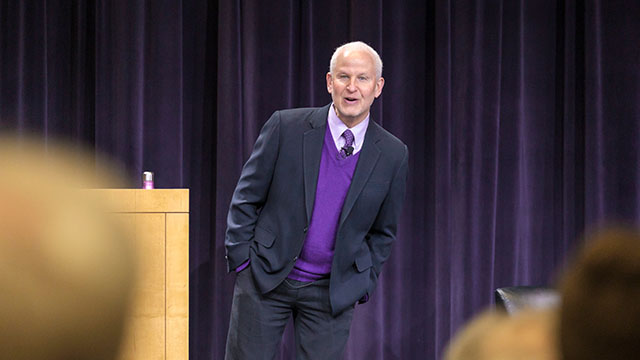Northwestern President Morton Schapiro delivered his second state of the University address on April 11, reiterating many of the themes he emphasized last week in Chicago — that Northwestern is on a solid financial track, that it continues to climb the rankings both nationally and globally, and that equalizing the undergraduate experience remains a top priority.
President Schapiro, speaking on the Evanston campus for the second of two annual “Conversations With the President” events, again touted the University’s rise in both federal research funding and reputation, but also focused on the human side of the equation.
He said he hoped that a part of his legacy will be the improved relationships between the president’s office and both the Faculty Senate and the Northwestern University Staff Advisory Council (NUSAC), which sponsored the event.
“I hope this is now part of the DNA of the University, because it's so important,” Schapiro said. “Without the 3,000 faculty and the 6,000-plus staff, we'd be nothing. It's true we have almost 20,000 students, but who teaches them? Who supports them? Who keeps the labs going? So, I'm really proud that we built those kinds of relationships and I hope that they're enduring.”
Thursday’s event, at McCormick Foundation Center, drew a capacity crowd. As was the case with the “Conversations” in Chicago, President Schapiro was joined on stage for a panel with three members of the University’s senior staff:
- Jonathan Holloway, provost and chief academic officer
- Craig Johnson, senior vice president for business and finance
- Jeri Ward, vice president for global marketing and communications
Asked during the panel portion of the event what Northwestern has done to support diversity and inclusion, Holloway noted there are task forces dedicated to gender, non-binary, queer and transgender issues; student, faculty and staff wellness; and other issues related to equity.
Borrowing a line from Associate Vice President for Equity Sarah Wake, Holloway said members of the Northwestern community need to treat each other with kindness.
“That’s fundamental and something Sarah talks about in her presentations as head of the Office of Equity,” Holloway said. “Her final bullet point is ‘just be kind.’ That’s not asking too much, I don’t think.”
Many of the questions — and answers — mirrored similar topics discussed at the Chicago “Conversations” April 3.
At that event, the president noted that Northwestern’s federal research funding has grown steadily to $702 million annually, helping fuel the surge in rankings to where the University is consistently listed in the top 15 institutions.
Schapiro took special pride highlighting the life-saving research Northwestern does that is changing the world.
The president spoke about the new Louis A. Simpson and Kimberly K. Querrey Biomedical Research Center, set to open in June at Northwestern Feinberg School of Medicine in Chicago, as well as the research breakthroughs that new building will make possible.
He said the new Simpson Querrey Biomedical Research Center (SQBRC) will help drive Northwestern in the coming years to surpass the $1 billion mark in research funding — along with even greater discoveries and the life-changing research that will help foster.
At both events, he singled out the work of transformative Northwestern researchers: bioelectronics pioneer John Rogers, the Louis A. Simpson and Kimberly K. Querrey Professor of Materials Science and Engineering at the McCormick School of Engineering,and pediatric dermatologist Dr. Amy Paller, chair of dermatology at Feinberg. They, along with dermatologist Dr. Steve Xu, developed a pair of soft, flexible wireless body sensors that could replace the tangle of wire-based sensors that currently monitor babies in hospitals’ neonatal intensive care units and pose a barrier to parent-baby cuddling and physical bonding.
Their discovery “will change neonatal units throughout the world,” President Schapiro said, noting he was deeply moved by the research when he read about it. “I thought about how it’s changing people’s lives.
“I'm proud to be associated with Northwestern. That made me cry. It's not just the ranking itself, it's what we are doing to justify that increase in ranking,” the president said. “It matters because the things we are doing that raise those rankings are things that are changing the world.”
It wasn’t the only major Northwestern headline-grabbing story Schapiro highlighted. On Thursday, he spoke again about the impressive “Caravans of Gold” exhibition at The Block Museum, which the president said he has visited twice. The exhibition, which runs through July 21, showcases the splendor and power of the lost kingdoms and commercial centers of Africa. The exhibition has been featured in media around the world.
“The world has learned about Africa and the role of Africa in the development of civilizations in a very different way than anyone ever thought about thanks to ‘Caravans of Gold,’” Schapiro said. “That's the stuff that motivates us to do the kind of work that we do. Right? It's not the rankings, it's the stuff like that.
Some 200 people packed Thorne Auditorium in the Arthur Rubloff Building for the first “Conversations,” with another 639 watching online. The second event, in Evanston, utilized overflow seating to accommodate the crowd. Another 652 watched online.
What follows is a recap of the Chicago event.
University finances
On the topic of University finances, the president acknowledged that he predicted incorrectly at last year’s “Conversations” that there would be no layoffs, based on information that was available at the time. He said by June of last year it became clear the University was running a deficit far greater than anticipated.
“It was very painful” to have to eliminate staff positions, he said.
The president said the University immediately enacted measures to cut the budget deficit, including the summer layoffs. By Aug. 31, the end of fiscal year 2018, Northwestern was $95 million in the red, he said.
At the next Board of Trustees meeting where this was discussed last year, President Schapiro said he made the board three promises:
- There would be no more fiscal surprises
- Northwestern would not give up any of the gains it has made over the years while climbing to become one of the top universities in the world
- The University would emerge more efficient than ever
The president said he knows the University’s faculty, staff and students have felt the impact of the layoffs and other financial constraints since last summer. But, he said, Northwestern has made significant progress since then.
Related: Watch the entire video of the Chicago event
He said there are weekly meetings to ensure the University is on track financially, and a new seven-year plan to make sure the new controls continue. Northwestern remains among the elite universities, and additional measures have been put in place to increase efficiencies, he added.
“We haven’t had any surprises from June 12 (2018) until today, and we are going to close this gap,” President Schapiro said. He said the University is now running a $47 million deficit — less than half what it was last summer — and he expects it to turn positive by the end of FY 2021.
“When I look back at the difficulties of the last two years, I'm proud that we dealt with it as a community,” he said. “We have gotten through it and have a seven-year plan. Not just a seven-week plan, but a seven-year plan. It allows us to teach at the highest-level graduate students and undergrads, to change the world, scholarship and clinical care and be the University that we dream to be associated with.”
A question submitted online from a Northwestern community member asked whether there would be salary increases. Johnson said there are plans for “modest salary increases” for both faculty and staff, with one caveat. “Highly compensated staff may be foregoing it this year,” he said.
Diversity, equity and inclusion
During the Q&A session, panel members were asked about progress on diversity issues. Although diversity and inclusion were central themes in the staff satisfaction survey, Provost Holloway said it was not a new idea or a new area of importance, but rather a special moment to rearticulate the University’s commitment to diversity, equity and inclusion.
“I want everyone to understand that the University’s commitment to provide, as far as staff is concerned, an equitable workplace where they are addressing equity in all the different dimensions — whether it’s pay, personal experience, issues of diversity — these are all really quite important to me personally, and, I know, important to everybody up on this stage as well.
“Finding the people and getting them to campus is important, but we must make sure that once they’re on the campus they have an experience that sets them up like everybody else to thrive. Not just to stumble their way through, but to thrive,” he said.
“That’s a lot more intense work, that’s about the inclusive experience,” Holloway stated. “We’ve got to get to a place where we are a university community, where everybody has an equal opportunity to thrive, and if nothing else, it will make our lives better in terms of being more productive in the research labs, in the classrooms, wherever you are touching the Northwestern experience — if we can actually realize our goals when it comes to diversity, equity and inclusion, it will be a better place.”
Global reputation
Asked about marketing the University’s global reputation, Northwestern’s Vice President for Global Marketing and Communications (OGMC) Jeri Ward talked about how her team is addressing the University’s global brand identity and eminence.
“Global is a major focus, and the department is focused primarily in three areas,” she said. “We need to make sure we have a concerted effort in terms of how we reach global audiences; we need to have good stories to tell those audiences; and finally, we need to focus across the University on the most impactful levers we can pull to improve our global rankings.
“For example, with the Amy Paller and John Rogers’ research on the patches, our team went after the wire services like Reuters and AP, and the story was picked up by the BBC, the China Morning Post and everywhere in between and received over 350 million media impressions,” she said.
Supporting researchers seeking grants
Responding to a question from an audience member about how the University can better support grant administrators, Johnson said it can be a challenge to keep the pool of research administrators flowing, particularly as Northwestern attracts more research dollars.
“Creating the infrastructure where you have enough folks that continue to populate these critical roles is going to be important,” he said. “We are actively looking at it to make sure we are not stymying the good growth that’s happening.”
Simpson Querrey Biomedical Research Center
Several questions from the University community centered around the new Simpson Querrey Biomedical Research Center – a 600,000-square-foot, 14-story building that will add approximately 2,000 jobs in biomedical research.
One person wondered whether the University’s financial situation will impact plans to fill the building. Another asked what plans are in place to fund research support services to ensure the research enterprise will operate effectively.
Johnson said building will be occupied according to plan, with people beginning to move in this month.
In terms of research support, Johnson said it is a team effort, with faculty, staff and students all contributing, and he said each of those functions needs to be staffed accordingly.
“As the building comes online, we are going to need to add more people,” Johnson said. “The actual research itself requires a good workforce, and we are dedicated to providing that.”


